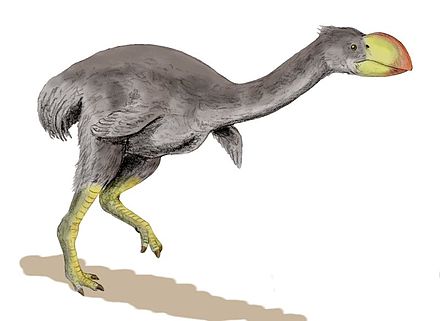Dromornis
The species were flightless, possessing greatly reduced wing structures but with large legs, similar to the modern ostrich or emu. They were likely to have been predominantly, if not exclusively, herbivorous browsers. The male of the largest species, Dromornis stirtoni, is a contender for the tallest and heaviest bird, and possibly exhibited aggressive territorial behaviour. They belong to the clade dromornithid, extinct flightless birds known as mihirungs.
The genus was erected to separate a new species, Dromornis australis, from the previously described Dinornis (giant moas), another lineage of ancient large and flightless birds found in New Zealand that was earlier described by Richard Owen in 1843. A femur that was forwarded to England, probably a dromornithid and since lost, suggested an Australian genus, but Owen withheld publication for many years. The type specimen, another femur, was found in a 55-metre-deep (180 ft) well at Peak Downs, Queensland, and subsequently described by Owen in 1872.[1] Owen's new taxon was published in a series on prehistoric birds, read before the Zoological Society of London then appearing in its Transactions.[2][3] The name of the genus is derived from Ancient Greek, dromos meaning running, a race, and ornitho, a bird.[4][5]
The genus and family are referred to as mihirung, distinguishing these birds from the giant emus. 'Mihirung paringmal' is an Aboriginal word from the Tjapwuring people of Western Victoria and it means 'giant bird'.[4]
The Dromornis lineage is proposed to represent a monotypic succession, from earliest to latest these are D. murrayi, D. planei, D. stirtoni, and this species, D. australis.[9]
The dromornithid family are sometimes known by appellations such as Stirton's mihirung (D. stirtoni) to refer to each species. Nicknames describing the species as 'thunderbirds' etc. have appeared in reports of their discovery, later terms such as "demon ducks"[10] refer to their relationship to the extant waterfowl of the galloanseres.[6][11]
Dromornis is a genus of large to gigantic flightless birds of the Dromornithidae family.[7] They lived from 8 million years ago until less than 30,000 years ago. Although they looked like giant emus, the Dromornis are more closely related to the earliest waterfowl of the Anseriformes order or a basal galliform. Comparative studies using endocranial reconstructions of dromornithids, Ilbandornis and three Dromornis species, suggest that the head and bill of the Dromornis lineage became foreshortened.[6]





